The NVIDIA GeForce RTX 2080 Ti & RTX 2080 Founders Edition Review: Foundations For A Ray Traced Future
by Nate Oh on September 19, 2018 5:15 PM EST- Posted in
- GPUs
- Raytrace
- GeForce
- NVIDIA
- DirectX Raytracing
- Turing
- GeForce RTX
Wolfenstein II: The New Colossus (Vulkan)
id Software is popularly known for a few games involving shooting stuff until it dies, just with different 'stuff' for each one: Nazis, demons, or other players while scorning the laws of physics. Wolfenstein II is the latest of the first, the sequel of a modern reboot series developed by MachineGames and built on id Tech 6. While the tone is significantly less pulpy nowadays, the game is still a frenetic FPS at heart, succeeding DOOM as a modern Vulkan flagship title and arriving as a pure Vullkan implementation rather than the originally OpenGL DOOM.
Featuring a Nazi-occupied America of 1961, Wolfenstein II is lushly designed yet not oppressively intensive on the hardware, something that goes well with its pace of action that emerge suddenly from a level design flush with alternate historical details.
The highest quality preset, "Mein leben!", was used. Wolfenstein II also features Vega-centric GPU Culling and Rapid Packed Math, as well as Radeon-centric Deferred Rendering; in accordance with the preset, neither GPU Culling nor Deferred Rendering was enabled.
| Wolfenstein II | 1920x1080 | 2560x1440 | 3840x2160 |
| Average FPS |  |
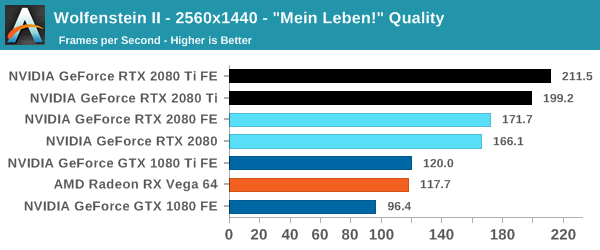 |
 |
| 99th Percentile | 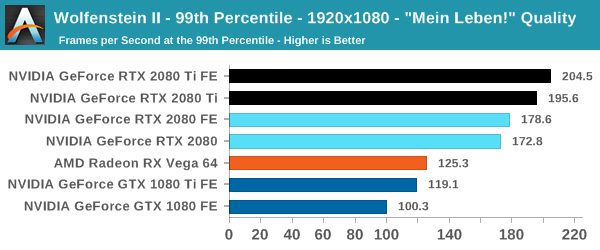 |
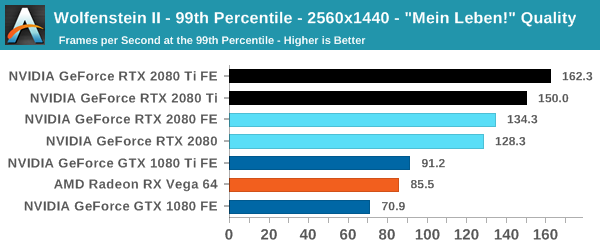 |
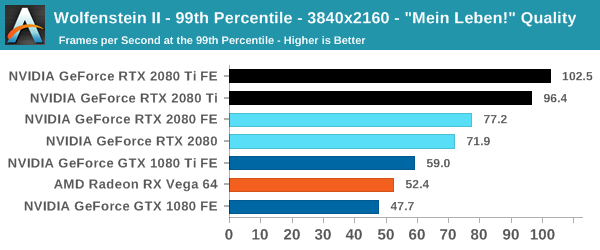 |
I am actually impressed with Wolfenstein II and its Vulkan implementation more than the absurd 250+ framerates, if only because many other games hold back the GPU because of the occurring CPU bottleneck. In DOOM, there was a hard 200fps cap because of engine/implementation limitations, a bit of a corner case, but manufacturers make 240Hz monitors nowadays, too. On a GPU performance profiling side, of course, reducing the CPU bottleneck makes comparing powerful GPUs much easier at 1080p, and with a better signal-to-noise than at 4K.
This is combined with the fact that at 4K, the 20 series are looking a huge 60 to 68% lead over the 10 series, and we'll be cross-referencing these performance deltas with other sections of the game. Even in the case of a 'flat-track bully' scenario where the 2080 Ti is running up the score, the 2080 Ti's speed compared to the 2080 is somewhat less than expected at 24 to 27%. It's a somewhat intriguing result for an optimized Vulkan game, as the game runs and scales generally well across the board; It's also not unnoticed that both the RX Vega cards and GeForce Turing cards outperform their expected positions, though without the graphics workload details it's hard to speculate with substance. With framerates like these, the 4K HDR dream at 144 Hz is a real possibility, and it would be interesting to compare with Titan V and Titan Xp results.


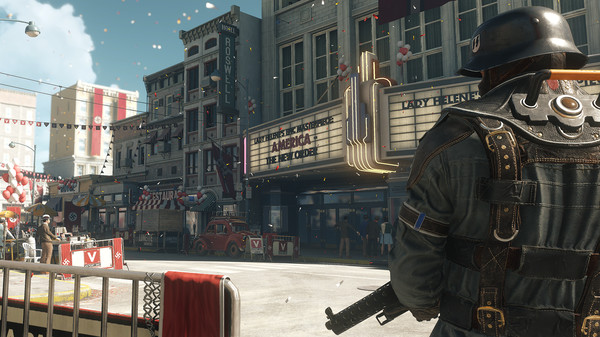









337 Comments
View All Comments
imaheadcase - Wednesday, September 19, 2018 - link
Because bluray players played movies from the start, delivered what they promised from the start even if cost a lot? Duh.PopinFRESH007 - Thursday, September 20, 2018 - link
They played DVDs from the start. Your statement is falseimaheadcase - Thursday, September 20, 2018 - link
Umm nope its true.Spunjji - Friday, September 21, 2018 - link
Yeah, there was media available at launch. Also Blu-Ray provided a noticeable jump in both quality AND resolution over DVD. RTX provides maybe the first and definitely not the second.V900 - Wednesday, September 19, 2018 - link
And it’s clear that you didn’t read the article, or skimmed it at best, if you’re claiming that “the two technologies have not even seen the real light of day”.The tools are out there, developers are working with them, and not only are there many games on the way that support them, there are games out now that use RTX.
Let me quote from the review:
“not only was the feat achieved but implemented, and not with proofs-of-concept but with full-fledged AA and AAA games. Today is a milestone from a purely academic view of computer graphics.”
tamalero - Wednesday, September 19, 2018 - link
Development means nothing unless they are released. As plans get cancelled, budgets gets cut and technology is replaced or converted/merged into a different standard.imaheadcase - Wednesday, September 19, 2018 - link
You just proved yourself wrong with own quote. lolGuess what? Python language is out there, lets all develop games from it! All the tools are available! Its so easy! /sarcasm
Ranger1065 - Thursday, September 20, 2018 - link
V900 shillage stench.PopinFRESH007 - Wednesday, September 19, 2018 - link
Just like those HD-DVD adopters, Laser Disc adopters, BetaMax adopters. V900 is pointing out that early adopters accept a level of risk in adopting new technology to enjoy cutting-edge stuff. This is no different that Bluray or DVDs when they came out. People who buy RTX cards have "WORKING TECH" and will have few options to use it just like the 2nd wave of Bluray players. The first Bluray player actually never had a movie released for it and it cost $3800."The first consumer device arrived in stores on April 10, 2003: the Sony BDZ-S77, a $3,800 (US) BD-RE recorder that was made available only in Japan.[20] But there was no standard for prerecorded video, and no movies were released for this player."
Even 3 years after that when they actually had a standard studios would produce movies for the players that were out cost over $1000 and there was a whopping 7 titles that were available. Similar to RTX being the fastest cards available for current technology, those Bluray players also played DVDs (gasp).
imaheadcase - Wednesday, September 19, 2018 - link
Again, the point is bluray WORKED out of the box even if expensive. This doesn't even have any way to even test the other stuff.. You are literally buying something for a FPS boost over previous gens that is not really a big one at that. It be a different tune if lots of games already had the tech in hand by nvidia, had it in games just not enabled...but its not even available to test is silly.